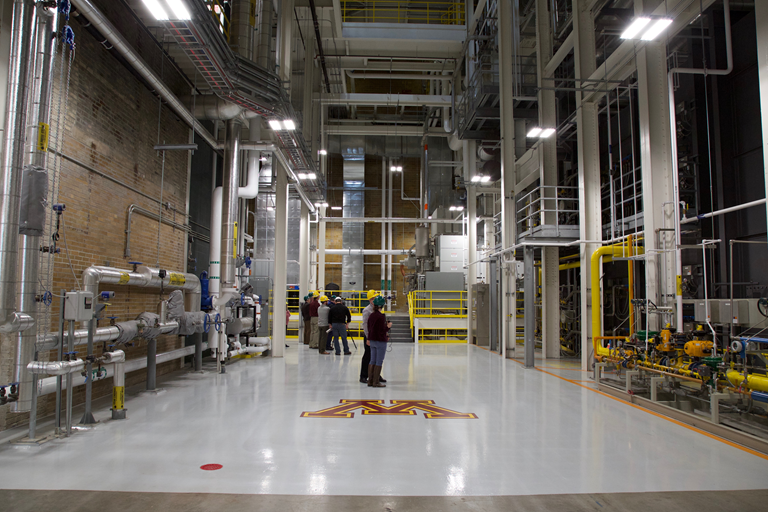Peter Myers, IDEA

An interview with Jerome Malmquist, Director, Energy Management, University of Minnesota at a recent media tour of the new CHP plant. Photo: Peter Myers, IDEA
A deteriorated, decommissioned 104-year-old heating plant on the University of Minnesota’s Twin Cities campus has been resurrected as a cutting-edge combined heat and power utility that is 83 percent energy-efficient – more than double the efficiency of a coal-fired power plant. On Dec. 19, the university hosted a media tour where visitors had the opportunity to see the facility and learn how it is enhancing reliability and sustainability while reducing operating costs. Local TV stations and Minnesota Public Radio covered the event.
The University of Minnesota has reinvested in the former Old Main Heating Plant, replacing old boilers with a new 22.8 megawatt combustion turbine and heat recovery system that will generate electric power and steam for the Minneapolis campus.
Fueled by natural gas, the Main Energy Plant is a key investment in the University’s climate action plan to reduce campus emissions in half by the year 2020. The plant went commercial on November 17, 2017. While operating, it reduces the University’s net carbon footprint by an estimated 10 to 13 percent and will provide the University with a more reliable source of energy, unaffected by supply disruptions to the local area grid.
"The Main Energy Plant allows the Twin Cities to operate as an energy island so that critical University services at hospitals, clinics and research facilities can be maintained if there are external outage events," said Jerome Malmquist, Director of Energy Management at the University of Minnesota.
The Main Energy Plant will save the University an estimated net $2 million annually in utility operating costs. The University recently received an additional $2 million one-time rebate from the Department of Commerce’s Conservation Improvement Program (CIP) for updating the plant to avoid fuel consumption that would be required with the addition of package boilers to meet the campus steam demand.
“The Main Energy Plant marries a historic site and decommissioned plant with world-class technology and environmental stewardship to support the University’s long-term research mission,” said Vice President of University Services Mike Berthelsen. “This is an exciting step that allows us to lessen our carbon footprint, while ensuring continuity of operations to campus and saving the University money.”
Co-generation means using the waste heat from the production of electricity to produce steam heat as a useful byproduct. The Main Energy Plant will produce and distribute over half the electricity for the East Bank campus. The residual heat from electrical production will be captured and used to produce steam to heat and cool most of the Minneapolis campus. During its construction, builders began placement of equipment for chilled water production so the plant can eventually grow to a full-service utility that will provide chilled water for air conditioning.
UMN’s new Main Energy Plant received $10 million from the state in the 2012 bonding bill. This project, under regulation from the Minnesota Pollution Control Agency, began in early 2015. The plant is located on the East Bank, west of the Education Sciences Building and the Dinkytown bikeway bridge.
Additional Media Coverage from the Event
University Of Minnesota Renovates Main Energy Plant - CBS Minnesota
U of M says New Energy Plant Means No More Power Outages - ABC Eyewitness News
More photos from the December 19th Media Tour
 Photo: Peter Myers, IDEA
Photo: Peter Myers, IDEA
 An interview with Mike Berthelsen,Vice President for University Services, University of Minnesota Photo: Peter Myers, IDEA
An interview with Mike Berthelsen,Vice President for University Services, University of Minnesota Photo: Peter Myers, IDEA
 Photo: Peter Myers, IDEA
Photo: Peter Myers, IDEA
#News#MemberNews#IDEAStaff#UniversityofMinnesota#Minnesota#UnitedStates#NorthAmerica#CampusEnergy#CHP#PromotingDistrictEnergy#DistrictHeating#SystemUpgrade#EnergyEfficiency#Reliability#Sustainability